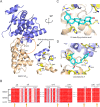Novel Chemical Ligands to Ebola Virus and Marburg Virus Nucleoproteins Identified by Combining Affinity Mass Spectrometry and Metabolomics Approaches
- PMID: 27403722
- PMCID: PMC4940736
- DOI: 10.1038/srep29680
Novel Chemical Ligands to Ebola Virus and Marburg Virus Nucleoproteins Identified by Combining Affinity Mass Spectrometry and Metabolomics Approaches
Abstract
The nucleoprotein (NP) of Ebola virus (EBOV) and Marburg virus (MARV) is an essential component of the viral ribonucleoprotein complex and significantly impacts replication and transcription of the viral RNA genome. Although NP is regarded as a promising antiviral druggable target, no chemical ligands have been reported to interact with EBOV NP or MARV NP. We identified two compounds from a traditional Chinese medicine Gancao (licorice root) that can bind both NPs by combining affinity mass spectrometry and metabolomics approaches. These two ligands, 18β-glycyrrhetinic acid and licochalcone A, were verified by defined compound mixture screens and further characterized with individual ligand binding assays. Accompanying biophysical analyses demonstrate that binding of 18β-glycyrrhetinic acid to EBOV NP significantly reduces protein thermal stability, induces formation of large NP oligomers, and disrupts the critical association of viral ssRNA with NP complexes whereas the compound showed no such activity on MARV NP. Our study has revealed the substantial potential of new analytical techniques in ligand discovery from natural herb resources. In addition, identification of a chemical ligand that influences the oligomeric state and RNA-binding function of EBOV NP sheds new light on antiviral drug development.
Figures






Similar articles
-
Crystal Structure of the Marburg Virus Nucleoprotein Core Domain Chaperoned by a VP35 Peptide Reveals a Conserved Drug Target for Filovirus.J Virol. 2017 Aug 24;91(18):e00996-17. doi: 10.1128/JVI.00996-17. Print 2017 Sep 15. J Virol. 2017. PMID: 28659479 Free PMC article.
-
Structural Insight into Nucleoprotein Conformation Change Chaperoned by VP35 Peptide in Marburg Virus.J Virol. 2017 Jul 27;91(16):e00825-17. doi: 10.1128/JVI.00825-17. Print 2017 Aug 15. J Virol. 2017. PMID: 28566377 Free PMC article.
-
Phosphorylated VP30 of Marburg Virus Is a Repressor of Transcription.J Virol. 2018 Oct 12;92(21):e00426-18. doi: 10.1128/JVI.00426-18. Print 2018 Nov 1. J Virol. 2018. PMID: 30135121 Free PMC article.
-
Review of pharmacological effects of Glycyrrhiza sp. and its bioactive compounds.Phytother Res. 2008 Jun;22(6):709-24. doi: 10.1002/ptr.2362. Phytother Res. 2008. PMID: 18446848 Free PMC article. Review.
-
Filovirus proteins for antiviral drug discovery: Structure/function bases of the replication cycle.Antiviral Res. 2017 May;141:48-61. doi: 10.1016/j.antiviral.2017.02.004. Epub 2017 Feb 10. Antiviral Res. 2017. PMID: 28192094 Review.
Cited by
-
High-throughput identification of G protein-coupled receptor modulators through affinity mass spectrometry screening.Chem Sci. 2018 Feb 20;9(12):3192-3199. doi: 10.1039/c7sc04698g. eCollection 2018 Mar 28. Chem Sci. 2018. PMID: 29732102 Free PMC article.
-
Flexible docking-based molecular dynamics simulation of natural product compounds and Ebola virus Nucleocapsid (EBOV NP): a computational approach to discover new drug for combating Ebola.BMC Bioinformatics. 2018 Nov 20;19(Suppl 14):419. doi: 10.1186/s12859-018-2387-8. BMC Bioinformatics. 2018. PMID: 30453886 Free PMC article.
-
Anti-SARS-CoV-2 Natural Products as Potentially Therapeutic Agents.Front Pharmacol. 2021 May 27;12:590509. doi: 10.3389/fphar.2021.590509. eCollection 2021. Front Pharmacol. 2021. PMID: 34122058 Free PMC article. Review.
-
Drug discovery from natural products using affinity selection-mass spectrometry.Drug Discov Today Technol. 2021 Dec;40:59-63. doi: 10.1016/j.ddtec.2021.10.005. Epub 2021 Oct 21. Drug Discov Today Technol. 2021. PMID: 34916024 Free PMC article. Review.
-
G protein-coupled receptors: structure- and function-based drug discovery.Signal Transduct Target Ther. 2021 Jan 8;6(1):7. doi: 10.1038/s41392-020-00435-w. Signal Transduct Target Ther. 2021. PMID: 33414387 Free PMC article. Review.
References
-
- Sanchez A. & Kiley M. P. Identification and analysis of Ebola virus messenger RNA. Virology 157, 414–420 (1987). - PubMed
-
- Sanchez A., Wagoner K. E. & Rollin P. E. Sequence-based human leukocyte antigen-B typing of patients infected with Ebola virus in Uganda in 2000: identification of alleles associated with fatal and nonfatal disease outcomes. The Journal of infectious diseases 196 Suppl 2, S329–336 (2007). - PMC - PubMed
Publication types
MeSH terms
Substances
LinkOut - more resources
Full Text Sources
Other Literature Sources
Medical
Miscellaneous

